Senior phase: headteacher survey
A report on the findings from an online survey of secondary school headteachers exploring their perspectives of implementing Senior Phase of Curriculum for Excellence.
Findings
This chapter sets out the aggregate level survey findings for the Scottish Government's Senior Phase headteacher survey.
Section 1: Leading the Senior Phase in my school
This section explores headteachers' views about leading the design and implementation of Senior Phase in their school. Headteachers were asked their views on the factors that both help and constrain the development of the Senior Phase, the variety of learning pathways provided to young people, and the learning / training that they have received in order to design and develop their Senior Phase.
Q1 Figure 1 below shows that 85% of respondents mostly or completely feel that they are achieving an integrated, progressive and coherent experience for young people in the Senior Phase, while 15% feel they are partially achieving this.
Figure 1: Extent to which headteachers feel achieved Senior Phase as an integrated, progressive and coherent experience for young people (BASE: 157 responses)

Q2 Three factors were identified by the majority of the headteachers as being helpful in developing a Senior Phase that meets the needs of young people: 'Support and insights of your staff', 'Commitment of partners with whom you have established relationships to help develop/deliver the Senior Phase' and 'Insights and expectations of young people'. Of the other factors, only 'Support and advice from your local authority' was identified by more than a third of the headteachers who took part in the survey, as shown in Figure 2.
Figure 2: Factors that help headteachers develop a Senior Phase that meets the needs of all young people (BASE: 159 responses)
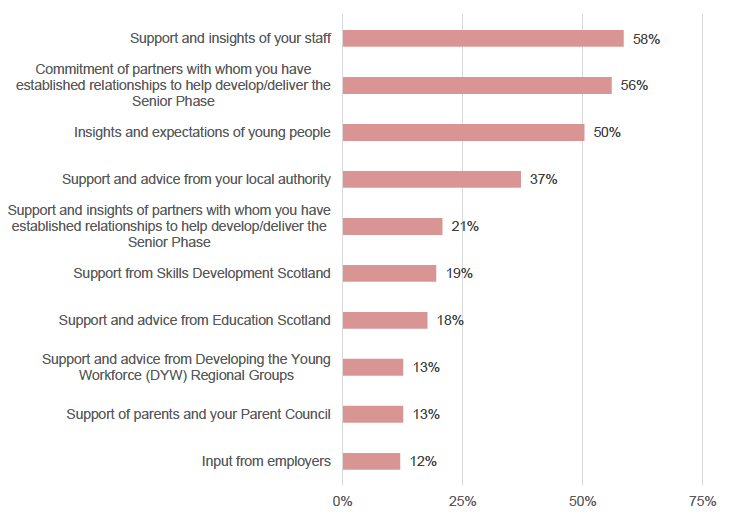
Q3 For three-quarters of respondents, timetabling pressures (74%) was the main factor that they report constrains on their ability to develop a Senior Phase that meets the needs of all their young people. All five factors listed in the question were identified as constraints by around half or more of respondents, as show in Figure 3.
Figure 3: Factors that constrain headteachers' ability to develop a Senior Phase that meets the needs of all their young people (BASE: 158 responses)
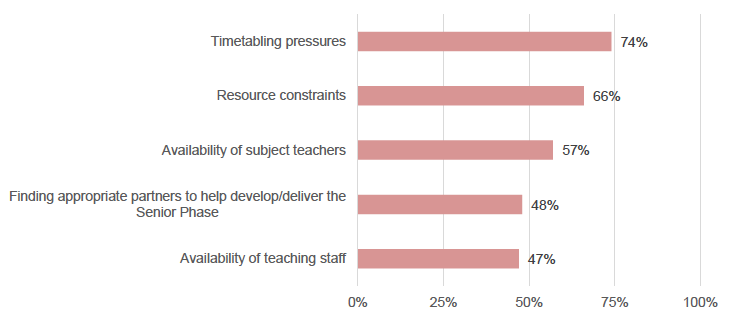
Q4 As shown in Figure 4 below, most of the headteachers (77%) were confident or very confident that their school provides a sufficient variety of learning pathways to meet the needs of all their young people across the Senior Phase. However, 13% were not confident, with a further 10% being unsure.
Figure 4: Confidence that school provides a sufficient variety of learning pathways to meet the needs of all young people across the Senior Phase (BASE: 158 responses)

Q5 Most of the headteachers (88%) report that they have sufficient autonomy to determine the pathways that their school offers in the Senior Phase. Figure 5 highlights that almost 90% agreed or strongly agreed that this is the case. Only 6 out of 158 respondents (4%) disagreed or strongly disagreed. Further research would help to provide further detail on experiences of autonomy in curriculum design.
Figure 5: Agreement with: I have sufficient autonomy to determine what pathways my school offers in the Senior Phase (BASE: 158 responses)

Q6 For almost all of the headteachers (94%), meeting the needs of learners to optimise their opportunities on leaving school is, by a clear margin, the factor that most influences how they lead the design of the Senior Phase. In comparison, each of the other listed factors were identified as an influence by less than half of respondents (Figure 6).
Figure 6: Factors that influence how headteachers lead the design of the Senior Phase in their schools (BASE: 158 responses)
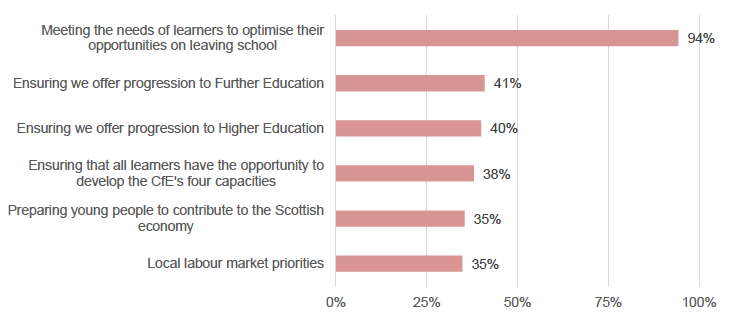
Q7 As shown in Figure 7, the majority (61%) of headteachers felt the training/professional learning they had received to enable them to design a Senior Phase had been helpful. 30% neither agreed nor disagreed with this statement and 9% disagreed or strongly disagreed.
Figure 7: Agreement with: The training/professional learning I have received to enable me to design a Senior Phase curriculum has been helpful (BASE: 159 responses)

Q8 As shown in Figure 8, the top three resources that headteachers agreed or strongly agreed are helpful in designing and implementing the Senior Phase offer were Learners: Requirements of learners (95%), Learners: Requests of learners (91%) and Guidance – Building the Curriculum series[5] (89%). In general, good practice from UK and international contexts were deemed less helpful.
Figure 8: Helpful resources for designing and implementing the Senior Phase offer[6]
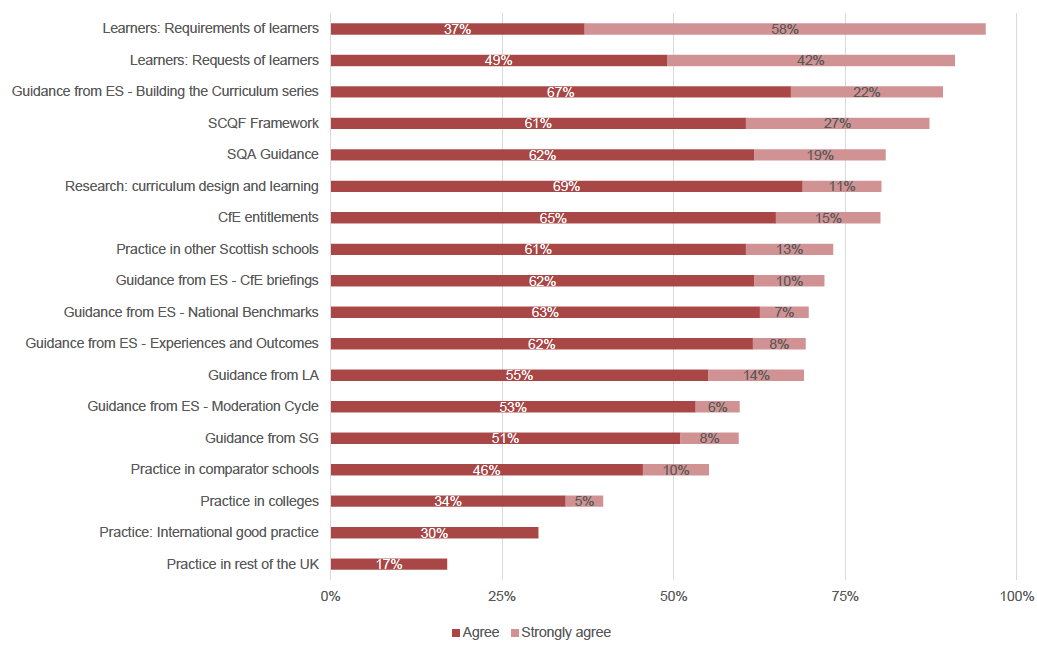
Q9 64 headteachers identified other kinds of support that would be helpful for designing and implementing the Senior Phase offer in their school. Overall, responses seemed to reflect the headteacher's individual school situation. However, two common themes emerged. The most frequently mentioned other type of support, which accounted for 11% of answers, was better and more affordable transport for young people to travel to work placements or courses offered elsewhere. Where appropriate transport was not available, distance learning was suggested as an alternative so that access to other relevant courses could be offered on site.
Moreover,9% of those who wrote about other kinds of support mentioned ways in which sharing of good practice could be improved to be more helpful. The key theme that emerged was that good practice models should be very detailed and reflect a broad variety of circumstances, for example, in terms of school size, geography or resources. This would allow schools to find a model that matches their particular circumstances as closely as possible.
Section 2: Curriculum model and approaches
This section of the report outlines what schools offer across the three years of the Senior Phase, and the rationale behind this. Headteachers were asked to indicate the number and types of subjects offered; how courses/qualifications are selected by young people; the rationale behind the Senior Phase offer; and the provision of Gaelic Medium Education (GME).
Q10 130 headteachers explained their rationale behind the Senior Phase curriculum in their school. The most frequently mentioned reasons were:
- Supporting young people in moving into a positive destination after school, which was explicitly mentioned by 59% of the headteachers (76 out of 130) who answered the question and was implicit in many of the remaining answers
- Meeting the needs of all young people in terms of learning, which was mentioned by 46% of headteachers (60 out of 130) who answered the question.
Headteachers mentioned a wide range of other motivating factors behind their Senior Phase offer, including supporting young people to achieve the best possible attainment and developing the four capacities to become successful learners, confident individuals, responsible citizens and effective contributors, as set out in the Curriculum for Excellence.
Q11 Table 4 below sets out the range of awards and qualifications offered by schools across the S4 – S6 year groups. The table does not show the actual uptake of these qualifications/awards within schools. Rather, the table shows the percentage of respondents indicating that this award/qualification was offered in their school at each of the Senior Phase years.
Some responses appeared incomplete or inaccurate based on other information about the school[7]. This may explain why some entries fall slightly below the 100% that might be expected. The most common qualifications or awards offered by schools are:
- In S4, over 90% of schools reported offering: National 3, 4, 5 and Duke of Edinburgh Awards
- In S5, over 90% of schools reported offering: National 4, 5, Higher, Foundation Apprenticeships and College provision
- In S6, 90% or more schools reporting offering: National 5, Higher, Advanced Higher, Foundation Apprenticeships and College provision (at a College).
Table 4: Qualifications and awards offered in the Senior Phase (BASE: 146 responses)
| Offered in Senior Phase | S4 | S5 | S6 |
|---|---|---|---|
| National 5 | 96% | 97% | 97% |
| National 4 | 97% | 93% | 84% |
| College provision at College (eg 1 day a week) | 75% | 93% | 90% |
| Duke of Edinburgh Award (Bronze, Silver, Gold) | 91% | 82% | 75% |
| National 3 | 97% | 75% | 69% |
| Higher | 43% | 97% | 97% |
| National Progression Awards | 55% | 78% | 77% |
| Volunteering | 49% | 73% | 86% |
| Foundation Apprenticeship | 18% | 94% | 92% |
| Skills for Work | 71% | 65% | 60% |
| SQA Awards | 62% | 66% | 66% |
| Saltire Awards | 55% | 61% | 69% |
| Advanced Higher | 6% | 27% | 95% |
| College provision at school | 42% | 43% | 41% |
| Third sector engagement | 35% | 41% | 42% |
| ASDAN Courses and/or Qualifications | 41% | 25% | 22% |
| Prince's Trust | 39% | 23% | 19% |
| National Certificates | 20% | 27% | 26% |
| John Muir Award | 39% | 15% | 13% |
| Scottish Vocational Qualifications | 19% | 22% | 22% |
| Higher National Certificates (HNCs) | * | 16% | 19% |
| Certificate of Work Readiness | 18% | 8% | 5% |
| City and Guilds Qualifications | 11% | 10% | 10% |
| Scottish Baccalaureate | 0% | * | 25% |
Q12 Headteachers report that the rationale behind their Senior Phase curriculum in general (see Q10 above) is supported by the range of awards and qualifications offered across the S4 – S6 year group in their school.
Q13 Headteachers were asked to indicate how many course choices (qualifications/awards) young people can select at each stage of Senior Phase (S4, S5, S6). The number of course choices that young people can select varied across S4, S5 and S6:
- In S4, 41% of respondents indicated that young people can select six and a further 48% indicated that young people can select seven course choices.
- In S5, almost three-quarters of respondents (74%) indicated that young people can select five course choices.
- In S6, 63% of respondents offer five course choices whilst just under 20% indicated six.
Figure 9 provides the full range of responses.
While headteachers were asked to state how many course choices (qualifications/awards) young people at their schools can select at S4, S5, and S6, they were not asked to indicate the types of courses this includes (i.e. those that are set out in Table 4 above), or how many young people at their schools went on to choose different types of course. These could be areas for follow up research.
Figure 9: Number of course choices (qualification/awards) that young people can select at each stage of the Senior Phase (BASE: 143 responses)[8]
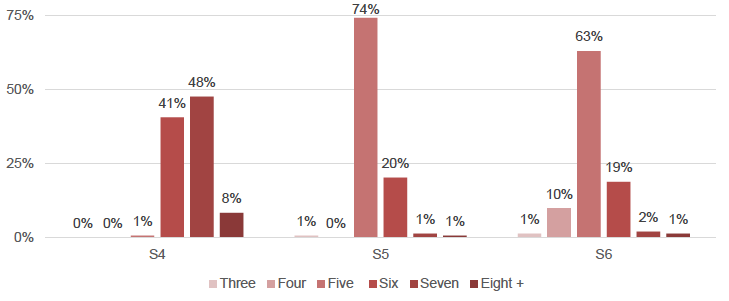
Q14 135 headteachers provided comments on how they accommodate young people who want to do more or fewer courses. Almost all (97%) of those who answered this question said that they were flexible in their approach and offered individualised timetables where possible. This could include choosing fewer subjects for those with additional support needs for learning or self-study options, additional course choices, volunteering, college or work experience for others.
A few of the headteachers indicated that they were not able to accommodate more or fewer course choices. These respondents either explained that they could not offer any flexibility due to the way that their local authority handled course choices, or they reported that choosing fewer or more courses was not something they feel able to recommend given how their curriculum is structured. It would be helpful to explore this feedback in more detail in follow up research.
Q15 Eight out of 147 schools (5%) who responded to the survey provide Gaelic Medium Education (GME) in the Senior Phase. For these schools, the most significant challenges in developing their curriculum for young people in GME are the availability of teaching staff and timetabling pressures. Conversely, staffing availability is seen as a factor supporting the development of a curriculum in GME.
Section 3: Transition from BGE to Senior Phase
This section of the report outlines headteachers' experience of planning the transition from Broad General Education (BGE) to the Senior Phase. Headteachers were asked about when they start planning their Senior Phase for young people in BGE and the rationale for this, as well as whether or not they are able to ensure continuity between the two.
Q16 For just over half of headteachers (54%), initial planning for the Senior Phase starts when young people are in S2 (see Figure 10). Headteachers were also asked to describe their rationale behind their approach to preparing young people for the transition, and this is explored below.
Figure 10: Stage start planning what will be offered in the Senior Phase for those young people currently in the BGE (BASE: 137 responses)

Q17 128 headteachers provided further explanation on why they start preparing for the transition at the relevant stage and how the BGE in their school prepared young people for the Senior Phase.
The main reason mentioned for starting to prepare in S1 was that starting as early as possible gives the young people and those supporting them plenty of time to consider a suitable choice of courses for the Senior Phase. Those who report starting to prepare for the transition in S2 said that this gives young people and those supporting them enough time to consider and refine their choices for the Senior Phase, while avoiding narrowing down options too early on. The main rationale given by those who start to prepare for the transition to the Senior Phase in S3 was that this could avoid limiting options too early.
What this data does not reveal is what these forms of preparation actually involve, and whether a responding headteacher was focusing on 'planning' in the narrow sense of working towards specific and binding course choices, or talking more generally about planning that includes opening up discussion and giving general guidance. Indeed, the answers seemed to suggest that headteachers may have been thinking about different types of preparation when responding.
Q18 Almost all (90%) headteachers felt they were able to mostly or completely ensure continuity of learning between the BGE and the Senior Phase. Just under one-tenth (9%) felt they were partially able to do this.
Figure 11: Extent to which headteachers feel they are able to ensure continuity of learning between the BGE and the Senior Phase (BASE: 138 responses)

Q19 127 headteachers identified the factors that helped them ensure continuity of learning between BGE and the Senior Phase. The open text responses were grouped thematically and are summarised in Table 5.
Table 5: Factors that helped headteachers ensure continuity of learning between BGE and the Senior Phase (BASE: 127 responses).
| Factor | % |
|---|---|
| Subject/Course choice discussion | 38% |
| Tracking for progress | 31% |
| Parental engagement | 27% |
| Profiling[9] | 27% |
| Information and advice from Skills Development Scotland (SDS) | 12% |
| Careful curricular planning | 12% |
| Learner Pathways | 12% |
| Use of My World of Work for parents and young people | 3% |
Q20 Headteachers were asked about the main factors limiting their ability to ensure continuity of learning between the BGE and the Senior Phase. From the list provided, most headteachers identified both timetabling pressures (75%) and the availability of teaching staff as barriers (75%). Only 20% indicated that the range of national qualifications/awards and work-based learning available limited their ability to ensure continuity.
A few headteachers (14% of those who answered the question) mentioned other factors limiting their ability to ensure continuity between the BGE and the Senior Phase. These included: a reduction in the number of choices for young people, some options being less popular and involving small class sizes, and the expectations of some parents.
Figure 12: Factors that limit ability to ensure continuity of learning between the BGE and Senior Phase (BASE: 121 responses).

Q21 38 headteachers provided other comments about the transition from BGE to the Senior Phase. Issues raised included: a view that the transition should be started earlier than S3; a need for stronger partnerships; a view that BGE does not prepare young people suitably for National Qualifications; and that the BGE is not suitable for some schools due to young people's more complex needs.
Section 4: Learner participation
This section outlines how headteachers include young people's voice in the design and implementation of the Senior Phase. Headteachers were asked about how young people select options in the Senior Phase, and the opportunities that exist for young people to shape their own curriculum in the Senior Phase. Guidance around course choices and support for parents/carers were also explored.
Q22 Headteachers were asked to identify the ways in which their young people select their Senior Phase options. The survey responses to the listed options are provided in Table 6.
Headteachers were able to state if there were other ways in which young people could select their Senior Phase options. A minority (n=36) responded and reiterated the list provided in the question. In some cases, headteachers indicated that the range of options their young people can choose from was informed by consultations with young people to ensure their interests are reflected.
Table 6: The ways in which young people select their Senior Phase options (BASE: 138)
| Options to select Senior Phase | % |
|---|---|
| They select courses from a school menu of opportunities | 51% |
| They select courses from a fixed number of options columns | 39% |
| They convey their interest irrespective of what is currently available, and we try to respond with courses | 33% |
Note: Respondents could select multiple options
Q23 Responses indicated that young people have a variety of opportunities to shape their Senior Phase (see Figure 13). Almost all headteachers (95%) indicated that young people can shape their Senior Phase through pastoral support discussions. Most headteachers also indicated that Careers Fairs (84%), and discussions between career advisers and young people that are fed back to senior staff (75%) provide opportunities for young people to shape their Senior Phase.
Figure 13: The opportunities that young people have in shaping the design of their Senior Phase (BASE: 137 responses).
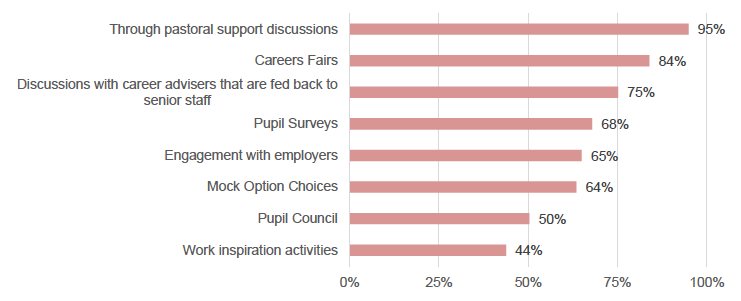
15 headteachers mentioned other opportunities for learners to contribute to shaping the design of the Senior Phase, including assemblies to get young people's opinions, individual meetings with young people and parents, and focus groups with young people.
Q24 In asking about barriers to enabling learners to contribute to shaping the Senior Phase, respondents most commonly selected capacity (61%)[10] and resources (54%). Time (37%) and a limited understanding / limited access to information on the part of parents/carers' (36%) are also considered to be barriers that prevent young people from shaping the Senior Phase design (Figure 14).
Figure 14: Barriers to enabling learners to contribute to shaping their Senior Phase (BASE: 138 responses).
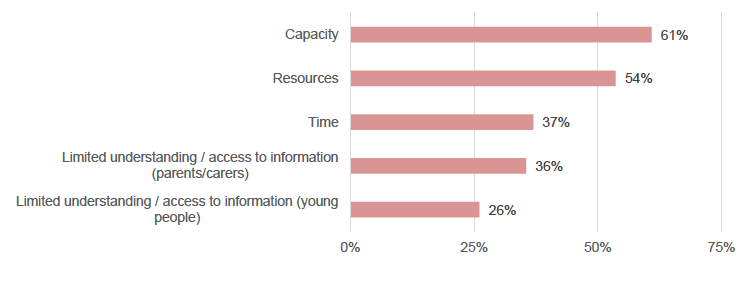
Q25 Table 7 shows that there is variation in the guidance that is offered to young people regarding their course choices, both in terms of the type of guidance, and the stage it is offered. Pastoral care in schools, SDS staff and other career advisors, and Personal Social Education (PSE) are commonly provided to young people across all stages of secondary school. In general, headteachers report that there is more guidance offered to young people at the later stages of their Senior Phase (ie S4 and S5) compared with the earlier stages across all forms of guidance. Careers fairs and evenings, and employer presentations, despite having a lower percentage, are still available to over 75% of young people in S4 and S5.
Table 7: Percentage of schools offering guidance to young people in S1- S5 (BASE: 138 responses).
| Available Guidance | S1 | S2 | S3 | S4 | S5 |
|---|---|---|---|---|---|
| Pastoral care in Schools | 75% | 97% | 100% | 99% | 99% |
| My World of Work | 87% | 94% | 98% | 95% | 92% |
| Personal Social Education (PSE) | 83% | 96% | 96% | 97% | 94% |
| SDS staff and other Career advisers | 67% | 88% | 96% | 96% | 95% |
| Option Assemblies | 20% | 84% | 85% | 91% | 87% |
| Attending career fairs | 28% | 51% | 70% | 87% | 87% |
| Careers evening | 27% | 62% | 74% | 78% | 76% |
| Employer presentation | 30% | 47% | 65% | 75% | 76% |
| Mentors | 14% | 14% | 29% | 51% | 43% |
22 headteachers provided further information about other guidance offered to young people regarding their course choices, including: meetings with parents and students; course choice booklets; online resources; events in partnership with universities; and working with SDS, youth services and apprenticeships to showcase opportunities.
Q26 51 headteachers commented on further support that would help them better respond to the different needs of young people. The most common form of support mentioned was staffing, with 26 headteachers (46% of those who answered the question) commenting that more staff are needed in their schools. This was followed by additional funding and resources, mentioned by 10 headteachers (21% of those who answered the question) and better links with employers and businesses, mentioned by eight headteachers (16% of those who answered the question).
Q27 Headteachers indicated that they support parents/carers in a number of ways to understand subject/course choice within the overall curriculum and the learner journey experience. The most commonly selected option was through individual discussions at parents' evenings with teaching staff (99%). Provision of information about potential subject choices (96%), and individual discussions at parents' evenings with careers advisors (93%), were also selected by almost all schools as contributing to the support they provide for parents / carers. Figure 15 shows the ways in which schools offer this support.
Figure 15: Support provided to parents/carers to understand subject/course choice (BASE: 138 responses).
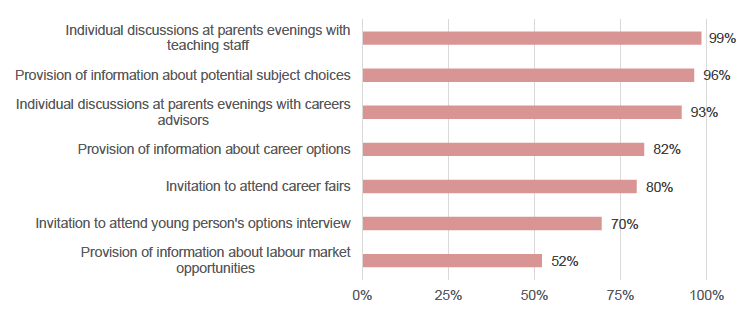
Q28 Headteachers were asked to indicate what (if any) were the main barriers they encounter in providing support to parents/carers. 81 headteachers provided comments on this, with the majority (65%) mentioning a lack of parental engagement as a barrier.
In addition, a few of those who responded to this question mentioned additional barriers in providing support to parents / carers including:
- Reaching out to hard-to-reach parents (eg those with language barriers or complex family circumstances) (14%)
- Lack of time among both parents and teachers (12%)
- Traditional or dated views about education held by parents (10%)
- Lack of or inadequate information or understanding among parents (7%); and
- Issues tied to travel and distance from the school (5%).
Q29 45 headteachers provided comments on what would help them better support parents/carers to understand the Senior Phase. Answers most commonly mentioned information and good practice examples about different pathways from sources such as the Scottish Government, Education Scotland and the Scottish Qualifications Authority (SQA).
Section 5: Collaboration, partnership and resources
This section outlines the current and planned relationships that headteachers have with other organisations and employers, and what they aim to achieve through these relationships. Headteachers were also asked about the factors that both help and limit the scope of collaboration, as well as the support they received to set up these partnerships.
Q30 Almost all (95%) respondents have established long-term partnerships with colleges. The majority (75%) also indicated established long-term relationships with employers. In almost all cases, long-term partnerships were more common than short-term partnerships, with the exception of those with 'Schools in other countries' where respondents were more likely to indicate they are short-term partnerships (Figure 16).
Figure 16: Established partnerships for the delivery and development of the Senior Phase (BASE: 136 responses)
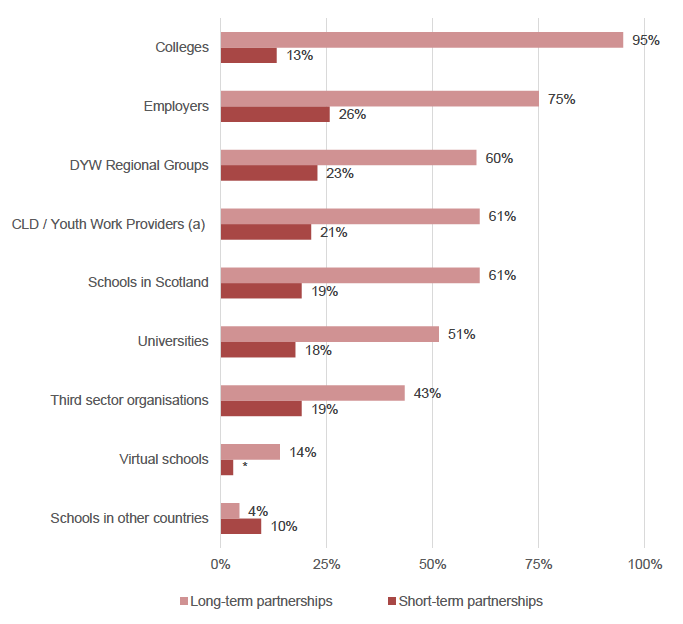
Note:
(a) Community Learning and Development / Youth Work Providers
* indicates where responses are ≤4 and have been surpressed in line with Scottish Government disclosure control checks
Q31 The survey also asked respondents about what they were seeking to achieve from these established partnerships. The options provided were: Direct access to employment opportunities; Wider experience for young people; Wider range of qualifications or awards; and Professional learning opportunities for staff.
Responses varied by type of partnership. For example, most (85%) seek to achieve direct access to employment opportunities for young people from employer partnerships. Almost all (93%) looked to college partnerships to ensure that a wider range of qualifications was available. In terms of gaining a wider experience for young people, headteachers looked to the following partnerships in order to achieve this:
- Colleges (85%)
- Employers (82%)
- Community Learning and Development/ Youth Work Providers (71%).
Across all partnerships, less than 50% of headteachers reported that they were seeking to achieve professional learning and opportunities for staff. Table 8 below shows the range of partners with whom headteachers have formed partnerships and what they seek to achieve from them.
Table 8: What headteachers seek to achieve through partnerships to develop and deliver their Senior Phase (BASE: 136)
| Direct access to employment opportunities | Wider experience for young people | Wider range of qualifications or awards | Professional learning opportunities for staff | |
|---|---|---|---|---|
| Colleges | 34% | 85% | 93% | 30% |
| Employers | 84% | 82% | 27% | 36% |
| Developing the Young Workforce (DYW) regional groups | 52% | 56% | 39% | 47% |
| Community Learning and Development/ Youth Work Providers | 22% | 71% | 56% | 23% |
| Universities | 9% | 53% | 44% | 37% |
| Schools in Scotland | 4% | 39% | 47% | 42% |
| Third sector organisations | 19% | 47% | 32% | 21% |
| Virtual schools | * | 10% | 13% | 4% |
| Schools in other countries | * | 7% | 4% | 9% |
Note:
Where the majority of headteachers (50% and above) have chosen an option, these have been highlighted.
Q32 In order to establish and maintain collaboration with partners, headteachers indicated that the three most important factors are: mutual willingness between partners (79%); mutual recognition of benefits (57%); and mutual capacity (46%) as shown Figure 17.
Figure 17: The most important factors to establish and maintain collaboration (BASE: 136 responses).
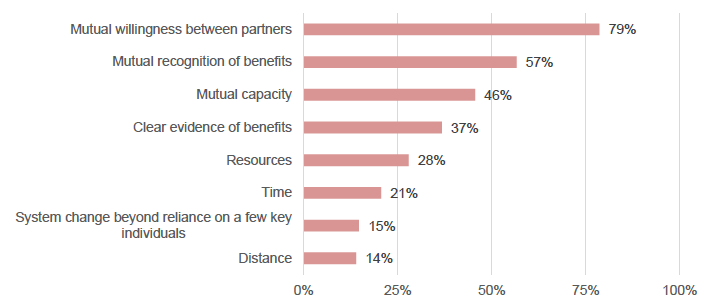
Q33 Headteachers were also asked about the factors that limit the scope of collaboration (see Figure 18). The cost of transport (72%) was identified by the majority of headteachers, followed by timetabling pressures (64%). A minority of headteachers identified that the cost of courses (33%) and the absence of options that young people are interested in (30%) limited the scope of collaboration.
Figure 18: Factors that limit the scope of collaboration (BASE: 134 responses).
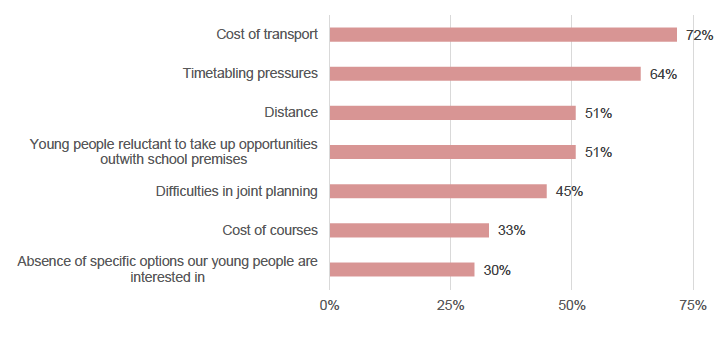
Q34 Headteachers were asked if they were satisfied with the support received to set up partnerships, from Local authorities, Education Scotland, DYW Regional Groups, Skills Development Scotland (SDS), and Regional Improvement Collaboratives.
In most cases, as shown in Figure 19, headteachers are generally satisfied with the support they have received from these groups/organisations to set up partnerships. Responses suggest headteachers are most satisfied with the support from SDS and Local Authorities, with 84% and 73% reporting that they are satisfied with support from these sources, respectively. Respondents seemed less sure about the support to set up partnerships from the recently established Regional Improvement Collaboratives; 51% reported that they neither agreed or disagreed that they are satisfied with this support.
Figure 19: Satisfaction with the level of support received to set up partnerships from the different organisations (BASE: 136 responses)
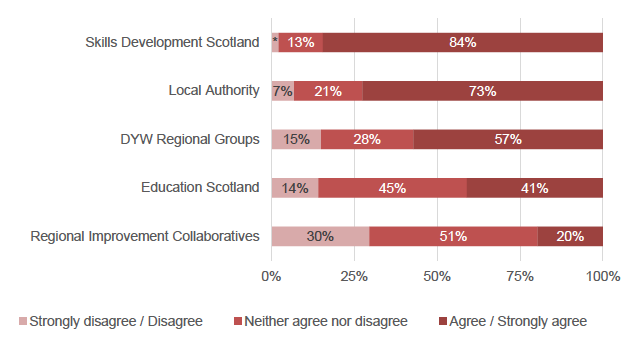
Note: * indicates where responses are ≤4 and have been surpressed in line with Scottish Government disclosure control checks
Q35 A small number of respondents (n=26) commented on additional support their school would find helpful in establishing these partnerships. The additional support most frequently mentioned was additional time to dedicate to partnership building, mentioned by 31% of those who provided a response. Another 19% of those who provided comments would find more staffing resources helpful.
Section 6: Outcomes and measuring success
This section outlines how headteachers measure the impact of ongoing work to develop the Senior Phase in their school. Headteachers were asked about the sources of evidence they draw on to ensure the needs of young people are met, and the additional support that would help them better understand impact in relation to the Senior Phase.
Q36 Commonly used sources of evidence to monitor the impact of Senior Phase include: Insight data[11] (86%), the views of young people (84%) and information on destinations (71%). Further detail is provided in Figure 20.
Figure 20: Sources of evidence to determine if the Senior Phase is meeting the needs of all young people (BASE: 136 responses).
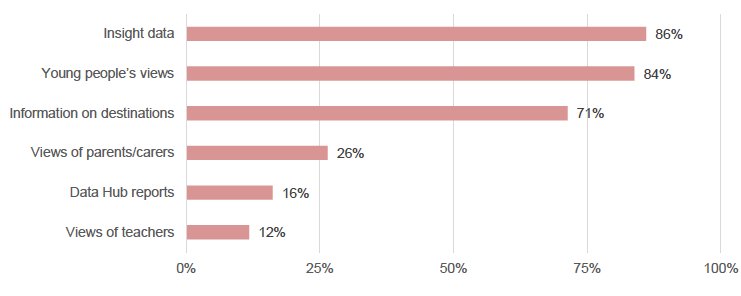
A small number of respondents (n=29) commented on the kind of support that would help them better understand and demonstrate impact in relation to the Senior Phase. The most commonly mentioned support, mentioned by 48% of those who answered the question, was support (such as training) for gathering and analysing data on the impact and added value of the Senior Phase.
Section 7: Next steps
This section gives an overview of the priorities that headteachers identified for further developing the Senior Phase in their school.
Q38 Most headteachers commented on their priorities for further developing the Senior Phase in their school, indicating that this is a topic of particular interest to those who responded to the survey. The four main priorities mentioned by headteachers are summarised in Table 9 below.
Table 9: Headteachers' main priorities for further developing the Senior Phase (BASE: 122 responses).
| Priorities mentioned | % |
|---|---|
| Enhancing and widening the current offer, for example by diversifying pathways and offering a broader choice of courses | 43% |
| Increasing and improving partnership working | 15% |
| Reviewing and evaluating the current Senior Phase curriculum | 10% |
| Refining the current Senior Phase curriculum | 10% |
Q39 38 headteachers provided further general comments about their experience of leading the development and implementation of the Senior Phase in their school. A recurring theme, mentioned by 18% of those who provided comments, was that headteachers feel there should be less of a rigid focus on the number of qualifications and more focus on the wider opportunities the Senior Phase can offer. Other comments included positive feedback on how the Senior Phase was being implemented in the school and the opportunities that were afforded to young people as a result.
Contact
Email: socialresearch@gov.scot
There is a problem
Thanks for your feedback